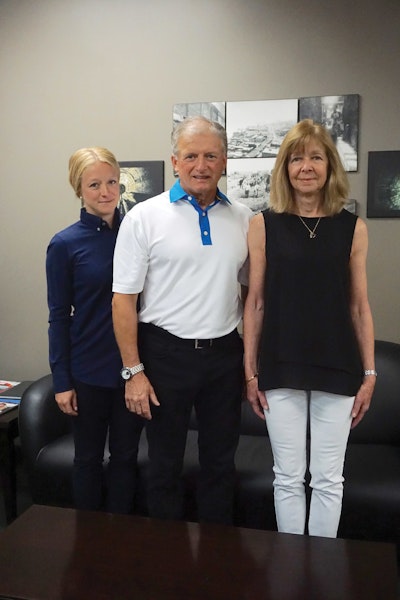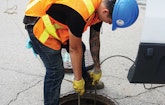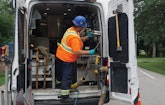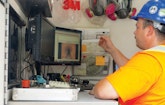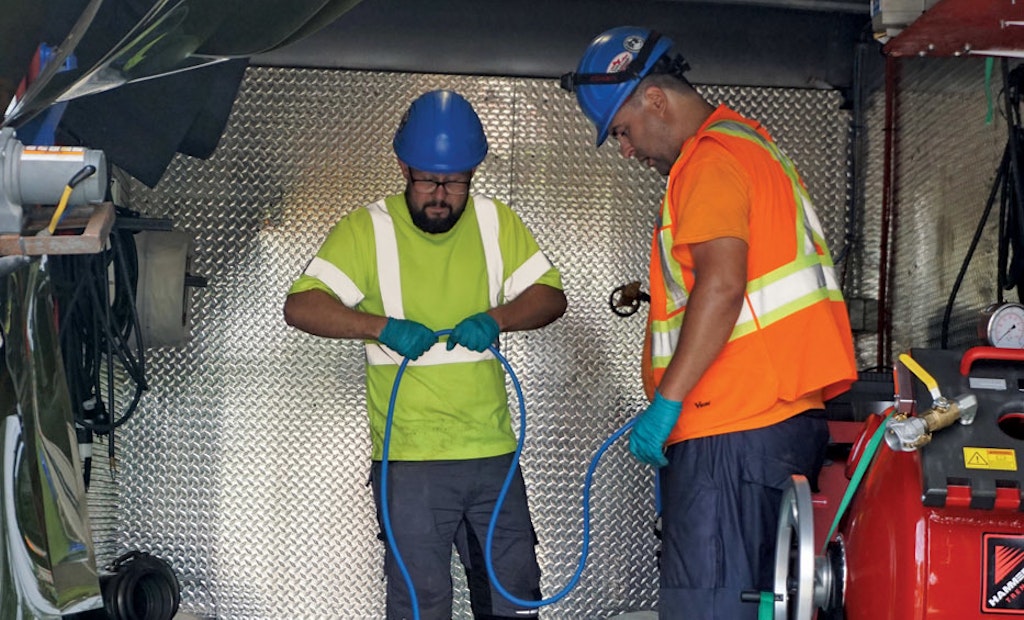
Technicians Ryan Bishop (left) and Roberto Larenjeiro prepare for a residential lateral lining job with a HammerHead Trenchless QuikLok inversion drum.
Interested in Relining/Rehab?
Get Relining/Rehab articles, news and videos right in your inbox! Sign up now.
Relining/Rehab + Get AlertsIn a span of 10 years, PipeFlo Contracting doubled its workforce to 60 employees and increased its annual revenue to more than $10 million.
That growth was driven by an emphasis on offering customers a suite of trenchless services while continually adopting new technologies that enable employees to provide those services efficiently and cost-effectively, says Julia Noble, who co-owns the Hamilton, Ontario-based company with her parents, Bruce and Darlene Noble.
“We kept adding services to better serve our clients,” she says. “Whenever we saw our customers had a need, we filled it. We grew organically by fulfilling those needs.”
Offering a comprehensive line of services allows PipeFlo to complete contracts in a timely manner for projects involving many different pipe sizes and rehabilitation requirements. “In effect, we’ve become like a small public works department that helps our clients resolve pipeline problems,” Bruce explains.
A plumber by trade, Bruce is no stranger to no-dig technology, having run a trenchless pipe rehab company from the mid-1980s to the late 1990s, when he sold it. “I remember going to the first trenchless technology trade show in Washington, D.C., around 1996,” he recalls. “The technology at the time was very rudimentary, but I saw huge upside in the benefits and advantages. I figured these new trenchless products would be the future of pipeline rehabilitation.”
When the Nobles established PipeFlo in 2003, they had no aspirations to develop a large business. At the time, the company’s services centered primarily on pipeline inspections and maintenance, with limited pipeline rehabilitation services.
But after Julia, armed with a business degree, joined the company in 2009 as a full-time director of operations and business development, its services broadened dramatically. Today, PipeFlo does UV-light-cured pipe lining and spot repairs, pipe bursting, sliplining, channel lining, pipe seals, sonar and laser profiling, and centrifugally cast concrete pipe lining.
“Younger blood comes into the company and all of a sudden, it’s just go, go, go,” Bruce says with a laugh. “You wake up one day and you have 45 to 50 trucks and 60 employees.”
More services, more equipment
Over the years, the company has built up a large fleet of equipment. For starters, it owns six Vactor combination vacuum trucks that feature 10-cubic-yard debris tanks, 300-gallon water tanks and 8,000 cfm Roots blowers (Howden).
For cleaning smaller-diameter pipelines, PipeFlo relies on a truck-mounted water jetter made by Harben. Mounted on a GMC flatbed truck, the unit features a 600-gallon water tank and a 4,000 psi, 16 gpm pump.
For inspecting mainline sewers, the company owns seven Mercedes-Benz Sprinter and Ford Transit vans equipped with CUES inspection camera systems. For larger-diameter pipes, the company relies on an Isuzu cube truck outfitted with laser and sonar profiling systems made by CUES.
For pipe lining, the company prefers fiberglass-reinforced liners made by BKP Berolina Polyester GmbH & Co. and cured with a UV light train built by IMS Robotics GmbH. To line laterals, PipeFlo uses the liners from LMK Technologies.
In addition, the company recently started using the Bluelight LED-curing system developed by Aarsleff Pipe Technology; the system now is produced and distributed in North America by HammerHead Trenchless. For lining short pipeline runs and connections, the company uses UV-light cure technology made by Cosmic Engineering GmbH.
European influences
Bruce says the company learns about new technology by attending trade shows in Europe. A good example is the UV-cured, glass-reinforced liner system the company purchased in 2006 from BKP Berolina in Germany.
“UV-cured liners cure faster than steam or ambient curing and there’s less chance of (lining) failure,” he explains. “It’s also a cleaner and quicker way to line pipes (the liners come ready to use, eliminating the time-consuming process of wetting out liners on site) and requires a much smaller equipment footprint on job sites.”
To line pipes with centrifugally spun concrete, PipeFlo invested in a CentriPipe high-speed spincast system manufactured by AP/M Permaform. The company uses AP/M Permaform’s PL-8000 concrete. The company also owns an AP/M Permaform system for lining manholes and other vertical structures.
For pipe grouting, PipeFlo invested in a CUES grouting system, carried on a 22-foot GMC truck chassis. The company uses grout made by Avanti International and a grout pump made by Cat Pumps.
The company has also invested in four robotic cutters made by Cosmic. They’re designed for performing more difficult and specialized tasks, such as cutting out intruding connections, removing hardened mineral deposits and reinstating laterals. The company also owns a HammerHead pipe bursting system.
To keep such a large inventory of specialized equipment in working order, the company employs a full-time mechanic. This helps minimize costly downtime on job sites and avoid the delays incurred when equipment must be sent back to a manufacturer for repairs. “Being able to repair specialized equipment in-house in a minimal amount of time adds value for us,” Julia says.
Diversity drives success
Meeting customers’ needs isn’t the only reason the company emphasizes service diversity. Bruce says the philosophy also allows PipeFlo to avoid using subcontractors, which gives it better control over quality and meeting project deadlines.
“Plus, if one area is slow, we can offer alternative work in another division,” Bruce adds. “That also helps us minimize layoffs because we can downsize crews in one area and shift them to another area to service a backlog of work. Diversity keeps employees engaged and builds a knowledgeable workforce. So it works as an employee-retention tool, too.”
Operating this way requires cross-training for technicians. Much of the training is provided by equipment manufacturers, while the balance comes from senior technicians that provide on-the-job supervision. An employee who wants to learn how to operate a vacuum truck, for instance, will “shadow” a senior leader on a truck for a few weeks, then get behind the wheel under that senior technician’s supervision, Julia says.
Within several weeks, the employee is allowed to go to a job site alone, but is supervised by another team leader on site. “The whole process might take anywhere from a month to two or three months, depending on how technical the service is,” she says. “In the end, we have some field staff who can operate a combo truck or a video truck, install a UV liner, and step in and help us perform confined-space entry work.”
Training reduces turnover
Cross-training helps the company work more efficiently because work doesn’t stop if employees get sick or take vacations. “From that standpoint, it’s very beneficial in terms of scheduling,” Julia says. But the variety of work also helps employees avoid burnout or boredom.
“It’s not easy working out in the field,” Julia says. “Sometimes a guy comes in and says he needs a break. So we can put him on another service for a week or two. We are fortunate to be able to provide them with a (job) change in-house, as opposed to losing valuable, trained employees to our competitors.
“Cross-training also keeps employees motivated because they know that if they can perform multiple services, they’ll always have work and steady employment,” she adds.
Management works with employees to determine what jobs they’d like to try. Sometimes a new employee might try several different positions, then talk with someone in human resources about where they fit the best. Doing work they enjoy also leads to better customer satisfaction, Bruce points out.
“The quality of work and the finished product is better when they get to choose what they want to do,” he says. “It’s a win-win-win situation for the company, the employee and the client.”
Running a cross-training program requires constant vigilance. Julia says that for each service the company provides, the company strives to have at least two employees who can operate each truck or machine.
Making sure the company can meet that standard requires daily meetings with dispatch operations personnel and monthly meetings with the company’s administration team. “We need to closely manage the quality assurance, production and efficiency of field operations,” she says. “We discuss ongoing contracts, labor requirements and truck situations. It gives everyone a chance to step back and see where we need to improve.”
An eye on technology
The Nobles anticipate further growth in the years ahead. But Bruce says it will be controlled growth, a philosophy that’s served the company well thus far. “We tend to take a giant leap forward, then pause to assimilate and integrate the new workload as best we can before we take that next leap,” he explains. “We’re very cautious when we expand.”
There’s a strong possibility the company will also expand its customer base geographically, too, as well as branch out into different but related services, such as relining water pipes. “It’s a new area of technology and a new market that we’re just starting to develop,” Bruce says. “We can’t use existing (pipe lining) technology because those liners aren’t designed to carry drinking water.”
But whatever PipeFlo does, it’s focus on new techniques, machines, equipment and processes will remain constant. “We’ll always have an eye on new technology,” he says. “You have to stay ahead of the curve — keep a keen eye out for new methods of infrastructure rehab.”
Working underwater
The value of PipeFlo Contracting’s emphasis on service diversity was vividly displayed during a challenging pipe bursting project near Ottawa, Ontario, in November 2017.
At issue was a 15-inch-diameter, roughly 230-foot-long corrugated pipe that carried stormwater from a parking lot at a nuclear plant into an adjacent river. “It was a very old pipe, corroded and rotted out,” says Bruce Noble, co-owner of the company, based in Hamilton. “There wasn’t much of it left.”
Replacing the pipe would’ve been prohibitively expensive. The project not only would have required building a cofferdam to create an excavation pit in the river, it also would have spurred a time-consuming and expensive permitting process and environmental assessment, Noble explains.
From its roster of available technologies, PipeFlo decided to use pipe bursting technology from HammerHead Trenchless. “We were told it’s difficult to burst corrugated pipe because it ‘accordions’ up,” Noble says. “But we welded a blade on the back of the pipe bursting head that split open the top of the pipe, which prevented it from folding up.”
Dave Allen, field operations manager at PipeFlo and a 15-year employee, developed a game plan for the process. “He’s an intelligent, innovative employee who always comes up with solutions for challenging projects,” Noble says.
Here’s how it worked: Using a 250-ton static-burst HammerHead unit, a work crew pulled the bursting head and the HDPE pipe from a pit dug near the building’s foundation. On the other end, the company employed scuba divers and barges to move the already fused-together length of pipe onto the river.
Initially, both ends of the pipe were capped, filling it with air to make it buoyant. Then the divers removed a cap on one end, which allowed it to fill with water and sink, he says.
The divers then connected the pipe to the bursting head, which was waiting inside the end of the deteriorating pipe, under about 12 feet of water. After that, crews started the pipe bursting process. The pipe bursting pull took an entire day; the whole project lasted about 2 1/2 weeks, Noble says.
“The client was very happy with the final result,” Noble says. “An opencut replacement would’ve taken forever, with all the environmental concerns. But we could circumvent all that with pipeline rehabilitation.
“Other companies they talked to didn’t know what to do. So they came to us and asked if there was any way to fix this. We get this a lot — customers asking us to fix problems that no one else can deal with. We figure if we all put our heads together, use our past experience and think it through, we can come up with a way to cross any hurdles.”
